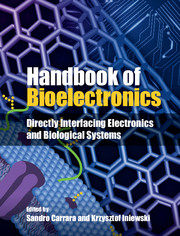Book contents
- Frontmatter
- Contents
- List of Contributors
- 1 What is bioelectronics?
- Part I Electronic components
- Part II Biosensors
- Part III Fuel cells
- Part IV Biomimetic systems
- Part V Bionics
- Part VI Brain interfaces
- Part VII Lab-on-a-chip
- Part VIII Future perspectives
- 40 Future perspectives in bioelectronics
- 41 Real-time activity energy expenditure estimation for embedded ambulatory systems using Sensium™ technologies
- 42 Electronic systems for health management
- 43 Linking the cyber and biological worlds: the Ensemble is the Function
- 44 Conclusion: Personal electronics and distributed theranostics
- Index
- References
44 - Conclusion: Personal electronics and distributed theranostics
from Part VIII - Future perspectives
Published online by Cambridge University Press: 05 September 2015
- Frontmatter
- Contents
- List of Contributors
- 1 What is bioelectronics?
- Part I Electronic components
- Part II Biosensors
- Part III Fuel cells
- Part IV Biomimetic systems
- Part V Bionics
- Part VI Brain interfaces
- Part VII Lab-on-a-chip
- Part VIII Future perspectives
- 40 Future perspectives in bioelectronics
- 41 Real-time activity energy expenditure estimation for embedded ambulatory systems using Sensium™ technologies
- 42 Electronic systems for health management
- 43 Linking the cyber and biological worlds: the Ensemble is the Function
- 44 Conclusion: Personal electronics and distributed theranostics
- Index
- References
Summary
We have seen in the different sections of this book that bioelectronics, bornin the early 1990s [1], has expanded over the years into several differentbranches. Bioelectronics now includes molecular components for electronicswith thin-film [2] and protein-based [3] transistors, bio-memories [4],nanogap devices [5] for single-molecule electronics [6], and single enzymesimmoblized on carbon nanotubes [7]. One of its major contributions to thestate-of-the-art of the modern technology is the branch of biosensors, wherebioelectronics has contributed to developing circuits for biomedicalapplications [8, 9], systems based on carbon nanotubes and proteins forapplications in personalized therapy [10, 11], contactless monitors formeasuring respiratory rate [12], and other very smart biomedical devices.Another fascinating branch is the development of biofuel cells based onenzymes [13], even implantable ones [14] that can exploit the body’smetabolism for their energy needs (Figure 44.1 illustrates a famousexperiment in which the energy recovered from the body of a lobster by usingan implanted biological fuel cell is used to power a watch). The moreadvanced developments in the field of electronics, such as epidermalelectronics [15] and memristors [16], have enabled the development ofbiomimetic systems such as electronic skin [17], electronic brains withconventional CMOS technology [18], with memelements [19] orwith organic polymers [20], and the design of synthetic genetic networks[21].
The new possibility of developing electronic skin as well as distributedneural systems brings us immediately to the area of bionics. Severalinnovative implantable devices have been proposed, some already on themarket and others coming soon: artificial cochlea [22], eyes [23, 24],muscles [25], bacteria [26], and even full arms [27] that enable amputees togo back to playing guitar again (Figure 44.2). Human/machineinterfaces have been pushed to the point of sending direct commands from thebrain to artificial arms [28].
Information
- Type
- Chapter
- Information
- Handbook of BioelectronicsDirectly Interfacing Electronics and Biological Systems, pp. 565 - 568Publisher: Cambridge University PressPrint publication year: 2015
